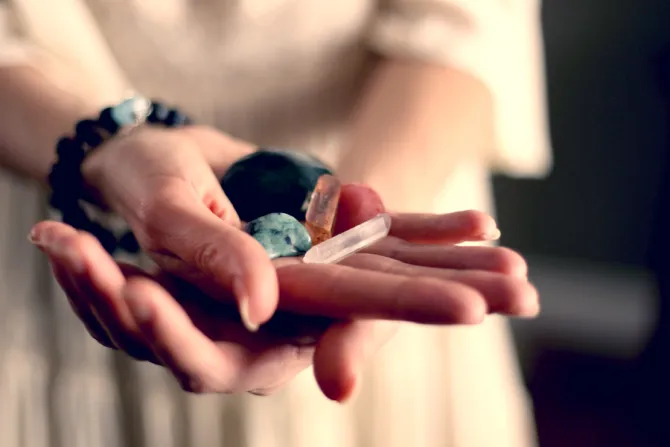Washington, D.C., Nov 30, 2018 / 03:22 am
To the outside viewer, crystals are pretty rocks.
Perfectly curated pictures of the pretty stones pepper the social media feeds of scores of millennials, as they have become increasingly popular on necklaces and as part of a "wholistic", wellness-minded life. But, more than just a fashion statement, crystals are believed by some to have healing properties, related to their energy or vibrations.
The Catholic Church rejects all things associated with New Age beliefs, including the trendy crystals, as heretical and dangerous.
At the same time, the Catholic Church embraces the veneration of relics.
To the outside viewer, relics are likely strange at best, and morbid at worst.
Relics are pieces of the body, clothing or other objects that have a direct association with a saint or with Jesus Christ. They may be pieces of bone or vials of blood collected after a saint has died, or a piece of their cassock, a book they used, or items that have been touched to these things.
Relics are venerated, often with a touch or a kiss, for the sake of the worship of God, and to ask the prayers of those saints.
So why is it ok for Catholics to kiss a vial of St. John Paul II's blood and pray for his intercession, but not ok for Catholics to cure their negative energy by wearing a rock around their neck?
It's all about who you want to establish a relationship with, explained Fr. Jim Orr, the director of St. Anthony's Chapel in Pittsburgh, which is home to 5,000 relics.
"The importance of the relics is their association with the saint, because while the saints would be in the glory of heaven, their body is still their body, so it's that association that makes the relics important, and, if you will, creates the connection," Orr told CNA.
"When one venerates a relic, one is essentially making a connection with the saint in the glory of heaven. So what is going on spiritually is a kind of prayer to the saint, invoking their intercession."
What makes a saint holy or worthy of veneration is not some kind of "spiritual radioactivity," Orr noted, but their holiness, which is how well they loved God and neighbor.
"Holiness is the difference between the world and those who follow Jesus Christ, and it's a difference of behavior," Orr said.
"Look at God's great commandments: love God with all your heart, mind and soul, love your neighbor as yourself, love one another as I have loved you. This is how they will know you are my disciples, by your love for one another."
"And any of the great saints, if you look at them, (that love) is the characteristic of their lives. So when we look at relics, or blessed or consecrated objects, it's about how they help us make the connection with those who have gone on into glory (in heaven)," he said.
In some ways, crystals are similar to relics, in that they are physical objects that can establish a spiritual connection. But it would be a mistake to think of them as anything but harmful, Orr said.
(Story continues below)
"It's far from harmless. This is thinly-veiled so-called witchcraft, which really is playing with demons," he said.
In the Vatican document "Jesus Christ: The bearer of the water of life", the Church teaches that all things associated with New Age beliefs, including crystals, must be rejected, as they claim to offer an alternative to the Word of God: "From the point of view of Christian faith, it is not possible to isolate some elements of New Age religiosity as acceptable to Christians, while rejecting others. Since the New Age movement makes much of a communication with nature, of cosmic knowledge of a universal good – thereby negating the revealed contents of Christian faith – it cannot be viewed as positive or innocuous."
Furthermore, the Catechism rejects New Age beliefs and the use of crystals: "All forms of divination are to be rejected: recourse to Satan or demons, conjuring up the dead or other practices falsely supposed to 'unveil' the future. Consulting horoscopes, astrology, palm reading, interpretation of omens and lots, the phenomena of clairvoyance, and recourse to mediums all conceal a desire for power over time, history, and in the last analysis, other human beings, as well as a wish to conciliate hidden powers. They contradict the honor, respect, and loving fear that we owe to God alone."
Father Gary Thomas, an exorcist for the Diocese of San Jose, told CNA that relics only obtain spiritual significance because they are associated with the saints. Saints are recognized as holy through the authority of the Church, which has its authority in God through apostolic succession, starting with the first Pope, St. Peter.
Crystals can have "perverted" spiritual energy through spells or pagan rituals that are performed with them, he said.
"Crystals can be used as conjuring objects for the demonic," Thomas told CNA. "I have had people come to me for deliverance who have been involved in the practice of using crystals for demonic musterings."
Orr, who has also been involved in exorcism ministry, said he too has seen people who have established connections with the demonic through their use of things like crystals.
"The demons go along until they can get their hooks into this person, and then they turn on them, and that's when we in the ministry see them, when they finally realize what they're dealing with, and they can't disassociate themselves from the demons," he said. That's when they come seeking the help of exorcists.
"So in that sense, that's how crystals are like relics. It's who you're creating a relationship with. The relics create a relationship with the saints and the glory of heaven; crystals create a relationship with demons."



